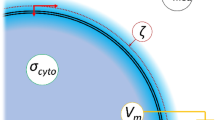Summary
A stopped-flow rapid reaction apparatus was used to study the rate of pH equilibration in human red cell suspensions. Flux of OH− or H+ was determined over a wide range of extracellular pH (4–11) in CO2-free erythrocyte suspensions. In these experiments, an erythrocyte suspension at pH 7.3 is rapidly mixed with an equal volume of NaCl solution at 3.0>pH>11.5. The pH of the extracellular fluid of the mixture changes rapidly as OH− or H+ moves across the red cell membrane. Flux and velocity constants can be calculated from the initiald pH/dt using the known initial intra- and extracellular pH. It was found that the further the extracellular pH is from 7.3 (in either direction from 4–11), the greater the absolute value of total OH− and/or H+ flux. Pretreatment with SITS (4-acetamido-4′-isothiocyanostilbene-2,2′-disulfonic acid), a potent anion exchange inhibitor, greatly reduces flux over the entire pH range, while exposure to valinomycin, a potassium ionophore, has no measurable effect. These data suggest that (i) both H+ and OH− may be moving across the red cell membrane at all pH; (ii) the species dominating pH equilibration is probably dependent on the extracellular pH, which determines the magnitude of the driving gradient for each ion; and (iii) the rapid exchange pathway of the erythrocyte membrane may be utilized for both H+ and OH− transport during CO2-free pH equilibration.
Similar content being viewed by others
References
Bidani, A., Crandall, E.D. 1978. Slow post-capillary pH changes in blood in anesthetized animals.J. Appl. Physiol. 45:674
Brahm, J. 1977. Temperature dependent changes of chloride transport kinetics in human red cells.J. Gen. Physiol. 70:283
Cabantchik, Z.I., Knauf, P.A., Rothstein, A. 1978. The anion transport system of the red blood cell: The role of membrane protein evaluated by the use of “probes”.Biochim. Biophys. Acta 515:239
Chow, E.I., Crandall, E.D., Forster, R.E. 1976. Kinetics of bicarbonate-chloride exchange across the human red blood cell membraneJ. Gen. Physiol. 68:633
Cousin, J.L., Motais, R., Sola, F. 1975. Transmembrane exchange of chloride with bicarbonate ion in mammalian red blood cells: Evidence for a sulfonamide-sensitive “carrier”J. Physiol. (London) 253:385
Crandall, E.D., Klocke, R.A., Forster, R.E. 1971. Hydroxyl ion movements across the human erythrocyte membrane.J. Gen. Physiol. 57:664
Crandall, E.D., Obaid, A.L., Forster, R.E. 1978. Bicarbonate-chloride exchange in erythrocyte suspensions.Biophys. J. 24:35
Dalmark, M. 1976. Effects of halides and bicarbonate on chloride transport in human red blood cells.J. Gen. Physiol. 67:223
Dalmark, M., Wieth, J.O. 1972. Temperature dependence of chloride, bromide, iodide, thiocyanate, and salicylate transport in human red cells.J. Physiol. (London) 224:583
Gunn, R.B. 1972. A titrable carrier model for both mono- and divalent anion transport in human red blood cells.In. Oxygen Affinity of Hemoglobin and Red Cell Acid-Base Status. M. Rørth and P. Astrup, editors. p. 823. Munksgaard, Copenhagen
Gunn, R.B. 1977. A titrable lock-carrier model for anion transport in red blood cells.Proc. Int. Union Physiol. Sci. Paris 12:122
Gunn, R.B., Dalmark, M., Tosteson, D.C., Wieth, J.O. 1973. Characteristics of chloride transport in human red blood cells.J. Gen. Physiol. 61:185
Gunn, R.B., Frohlich, O. 1979. Asymmetry in the mechanism for anion exchange in human red blood cell membrane.J. Gen. Physiol. 74:351
Itada, N., Forster, R.E. 1977. Carbonic anhydrase activity in intact red blood cells measured with18O exchange.J. Biol. Chem. 252:3881
Jacobs, M.H., Parpart, A.K. 1932. Is the erythrocyte membrane permeable to hydrogen ions?Biol. Bull. 42:63
Jacobs, M.H., Stewart, D.R. 1942. The role of carbonic anhydrase in certain ionic exchanges involving the erythrocyte.J. Gen. Physiol. 25:539
Jennings, M.L. 1976. Proton fluxes associated with erythrocyte membrane anion exchange.J. Membrane Biol. 28:187
Jennings, M.L. 1978. Characteristics of CO2-independent pH equilibration in human red blood cells.J. Membrane Biol. 40:365
Lambert, A., Lowe, A.G. 1978. Chloride/bicarbonate exchange in human erythrocytes.J. Physiol. (London) 275:51
Lassen, U.V. 1972. Membrane potential and membrane resistance of red cells.In: Oxygen Affinity and Red Cell Acid-Base Status. M. Rørth and P. Astrup, editors. p. 291. Munksgaard, Copenhagen
Obaid, A.L., Crandall, E.D. 1979. HCO −3 /Cl− exchange across the human erythrocyte membrane: Effects of pH and temperature.J. Membrane Biol. 50:23
Rothstein, A., Cabantchik, Z.I., Knauf, P. 1976. Mechanism of anion transport in red blood cells: Role of membrane proteins.Fed. Proc. 35:3
Author information
Authors and Affiliations
Rights and permissions
About this article
Cite this article
Critz, A.M., Crandall, E.D. pH equilibration in human erythrocyte suspensions. J. Membrain Biol. 54, 81–88 (1980). https://doi.org/10.1007/BF01940562
Received:
Revised:
Issue Date:
DOI: https://doi.org/10.1007/BF01940562



